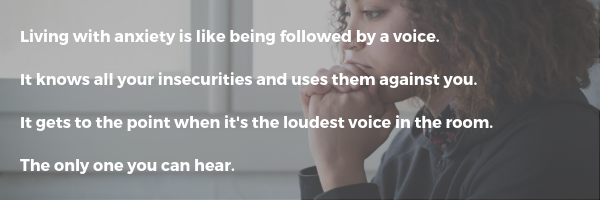We all have anxiety.
“I’m not ready to take the test!”
“I can’t give a speech!”
“I have a stomachache!”
Each of us can relate to feeling uneasy about getting on a plane, angst about going to a job interview, or queasy before giving a speech. The difference between “typical” or “healthy” anxiety and anxiety disorders is the disorders interfere with life and stop us from doing things we want, or need, to do. Instead of feeling uneasy, angst, or queasy, and doing it anyway, people with anxiety disorders find they cannot do the things they need to do in their lives.
In our classrooms, we see students experiencing panic attacks, stomachaches, restlessness, tension, worrying, sweating, inability to concentrate, feeling tired or weak, or a sense of foreboding or doom. Beyond these symptoms, anxiety can present as anger, fear, impatience, frustration, and an inability to complete schoolwork or to meet educational demands.
According to the Child Mind Institute’s 2018 report on Mental Health there are six different types of anxiety disorders: separation anxiety, social anxiety, selective mutism, generalized anxiety, specific phobias, and panic disorder.
The Child Mind Institute report lists the following behaviors as indications of a potential anxiety disorder(s):
- Inattention
- Worrying
- Missing class
- Not wanting to leave friends or parents
- Not wanting to answer questions
- Frequent trips to the nurse’s office
- Avoiding friends
- Wanting to work alone
- Having problems in certain subjects
- Disruptive behaviors
Behind the symptoms of anxiety are real people with real stories about the often debilitating effects of anxiety. Read how Alicia, Brian, and Joey experienced anxiety in their stories, below.
1. Alicia Tatar
A first-hand account of generalized anxiety disorder by Alicia Tatar. Alicia shares how she avoided going to school, made frequent trips to the nurse’s office, and resorted to self-harming behaviors before getting the help she needed.
2. Brian Longo
My Silent Child is the story of 5-year-old Brian who only speaks at home with his family, and not at school. Brian’s disorder is called selective mutism.
3. Joey’s Story
Separation Anxiety is the focus of this story about Joey who struggled with being away from home and spending time at school away from his parents. Joey’s anxiety manifested in his continuous worries about his parents’ safety.
Because it can be tricky to discern between healthy anxiety and an anxiety disorder, it is wise to consult with your school’s support staff–a school nurse, social worker, or school counselor.
What causes anxiety disorders?
According to this study from the Mayo Clinic, medical conditions can trigger anxiety as well as the following risk factors:
- Genetics
- Stress
- Mental Illness
- Personality
- Substance Abuse
- Trauma
Out of this list of anxiety risk factors, childhood trauma has been the focus of many recent studies and news stories. Most notable is the ACE Study, which defined how adverse childhood experiences can affect one’s future mental health. Specifically, the ACE Study measures how risk factors such as abuse, neglect, isolation, stress, substance abuse, etc. and how protective factors such as support, education, caring adults, housing, employment, etc. impact our mental health.
Anxiety has a voice of its own.
The impact of anxiety can be debilitating and can impact our students’ success in, and outside of, school. Understanding the symptoms and behaviors associated with anxiety helps us to better understand our students and how to guide them to seek help from school resources. Anxiety disorders can be caused by medical conditions, trauma, and many other factors. The ACE Study shows how adverse childhood experiences affect us and outlines the preventative measures we can take to ensure our students pursue lifelong mental health and wellness.
Sources:
Anxiety disorders. (2018, May 04). Retrieved from https://www.mayoclinic.org/diseases-conditions/anxiety/symptoms-causes/syc-20350961
Child Abuse Prevention | Features | CDC. (n.d.). Retrieved from https://www.cdc.gov/features/healthychildren/index.html
Novak, L. (2018) Can childhood trauma cause anxiety? Bridges to Recovery. https://www.bridgestorecovery.com/blog/can-childhood-trauma-cause-anxiety-whats-the-best-way-to-approach-treatment/ Retrieved 5/10/19.







